“One of the most scenic drives within the Tokyo-Yokohama area, and one that makes for a most pleasant weekend, is the journey around the Five Lakes at the base of Mt. Fuji, and on a clear day, the scenery is unsurpassed anywhere in the world.
“… The drive begins with a charming scene as you travel above the Gohra Gorge and look down several hundred feet to the raging mountain stream below … At the bridge, you will start to travel on a gravel and dirt road, which is very good but somewhat narrow.
“Just prior to reaching Sengoku Golf Course, you will begin to climb up into Nagao Pass. Going up through the Pass, you will notice a series of terraced rice paddies in the valley below and to you left, with stone retaining walls which are quite unique, and bubbling along beside is a crystal-clear mountain stream abounding with trout.
“You climb to the top of Nagao Pass by a very narrow winding road which is quite good but necessitates cautious and sensible driving. This Pass is also known as Long Tail Pass [na-ga-o], and at its summit you are at a height of 2,962 feet. An exceptional view of Mount Fuji, from base to summit, can be seen on a clear day, as well as sparkling Lake Hakone off to your left in the distance.
“From the top of the Pass, you will wend you way down through a tree-covered mountain lane into the town of Gotemba at the foot of Mt. Fuji.”
– Motoring in Japan, by Bob Frew, 1955
“The motor car swung ’round the sharp turn and entered the dim tunnel with unexpected abruptness. In the half-light we could see the curved roof and brick walls that encompassed us. Then we came swiftly into the light with a suddenness that dazzled us and brought up at the little tea house that sat perched on the side of the road.
“Then it was that we became conscious for the first time of the glorious vision that filled the skyline before us. At our feet, the mountain side fell away in a long gentle slope to the plain some two thousand feet below. Bisecting this level valley ran the railway tracks, like a black cord thrown carelessly down, looping and twisting its way from Tokyo.
“Beside it we could see a town, and beyond that the brown fields that gradually melted into the swelling hills. These merged into the mountain and continued in unbroken rise into the perfect one of Fujiyama, towering above, the light veil of cloud that hung two-thirds of the way to the summit.
“Although the mountain was a full thirty-five miles away, in the clearness of that afternoon it looked like it could almost be touched. A bank of snow caught in one of the ravines flashed back the afternoon sun and the shadows showed very black in the gullies and cuts that gashed the rugged sides.
“In silent awe, we sat on the benches and drank in the lovely spectacle. It was too big for words – they did not seem adequate. The bigness – the silence – the dominance – the perfect form and immutability of it, checked us from marring with sound the message that came from it to our eyes.”
– “Over and Around Mt. Fuji”, by John Sharrock, Japan: An Illustrated Magazine of Oriental Travel, August 1922



